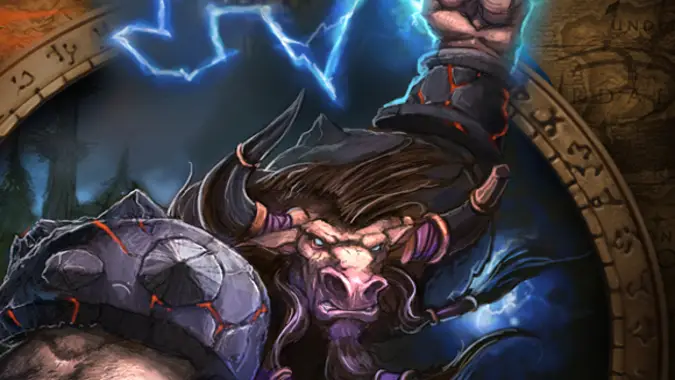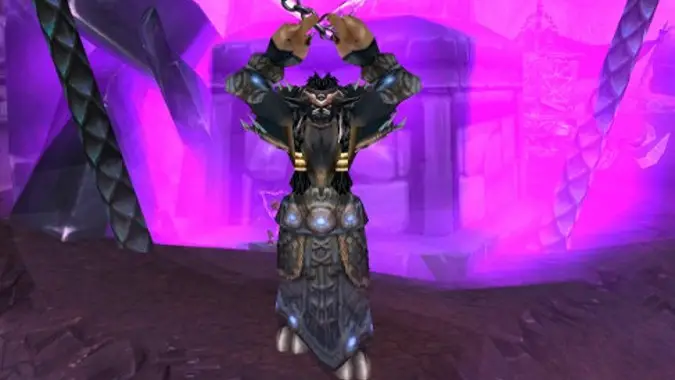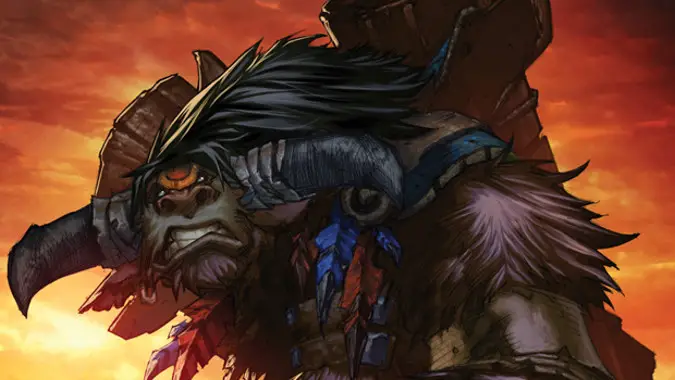Know Your Lore: The origins of the Tauren and the sorrow of the Earthmother

When talking of the origin of the Tauren, we can look to their own myths, and then consider what they might mean. As written in Mists of Dawn, the Tauren creation myth, their origin is as follows:
While the right eye shone down upon the golden dawn, the Earthmother’s gentle hands spread out across the golden plains. Wherever the shadow of her arms passed, a noble people arose from the rich soil. The Shu’halo (the tauren) arose to give thanks and prayer to their loving mother. There, in the endless fields of dawn, the children of the earth swore themselves to her grace and vowed to bless her name until the final darkening of the world.
Mists of Dawn reveals as well that the right eye of the Earthmother was An’she, the Sun. What’s interesting is that the Tauren were created by the Earthmother blocking the rays of the sun with her arms and hands — the Tauren were born in an absence, not a presence, of light. One must ask why the Earthmother chose this method to see the Tauren come into existence — is there a reason that the Tauren must be familiar in their very moment of creation with both darkness and light?
Beyond the Mists of Dawn
As mentioned in our recap of the various native races of Azeroth, the Tauren are a fairly adaptable race. There are three ‘sub-species’ of Tauren alive today — the Taunka, the Yaungol, and the Tauren proper, who call themselves Shu’halo in their native language. What’s interesting is that the Tauren aren’t as morphically adaptive as, say, the Trolls. When placed in a new environment, they do change to become part of it, but they don’t take on, say, the extreme physical adaptations of the Frost or Sand or Forest or Jungle Trolls. While the Yaungol and the Taunka do physically differ from their Tauren relations, these changes are reasonably explained by a simple period of long separation. There’s nothing inherently magical about these differences. Indeed, one couldn’t even really say that one of these races is the clear ancestor of the other two.
This brings to mind the question — are any of them? Are modern Tauren, the ones who live in Mulgore and who form the backbone of the Horde, ancestral to the other two? Or are all three derived from some older stock, and if so, what happened to it?
As the children of the earth roamed the fields of dawn, they harkened to dark whispers from deep beneath the world. The whispers told the children of the arts of war and deceit. Many of the Shu’halo fell under the shadow’s sway and embraced the ways of malice and wickedness. They turned upon their pure brethren and left their innocence to drift upon the plains.
Corrupting whispers
Now, for those of us who’ve played the game for a while, this all seems very suspiciously familiar. The dark whispers from deep beneath the world sound like the same voices that corrupted the Earth Warder Neltharion into Deathwing, the pernicious and mad Old Gods. The idea that the Shu’halo learned of war and deceit from these beings, becoming malicious and wicked and turning upon their ‘pure’ brethren leads us to consider several questions.
- If there was a war between corrupt and uncorrupted Tauren (the ‘pure brethren’) when did this happen?
- Who won? Who lost? What was the outcome of this conflict?
- Are any of the modern Tauren peoples descended from the wicked ones? Are all of them?
The rest of Sorrorw of the Earthmother seems highly figurative, as the Earthmother rips out her own eyes to avoid seeing the corruption of her chosen people. An’she and Mu’sha, the Sun and Moon, are left to chase one another endlessly across the sky in a futile attempt to console one another from the loneliness of the Earthmother’s action, while she herself bends her ear to listen to her children. What the myth never actually states is if her wisdom purged the wickedness from them. Her great heart was always with her children — and her loving wisdom never fled from them. That’s how the myth ends.
The lonely paths of exile
There is in fact no continuation of this story in any of the other extant Tauren myths we have, nor in the scraps we have of Taunka or Yaungol history. We know that both these sub-species were isolated in harsh lands and found ways to survive. The Yaungol used fire and the burning oil of their native Townlong Steppes as a weapon, going so far as to set themselves on fire — indeed, the demigod Ordos attained his power by listening to the whispers of the lords of fire and setting himself ablaze, his eternal agony converted into pyrrhic power. The Taunka adapted to the frigid climes of Northrend by learning the path we today call ‘Dark Shamanism’ — it’s telling that Garrosh Hellscream’s True Horde learned how to bend and force elemental spirits to their will by studying the ways of the Taunka.
Okay, you might be saying, clearly the Yaungol and the Taunka are candidates for descending from the wicked ones mentioned in Sorrow of the Earthmother. But not our Earthmother-loving modern Tauren, the Shu’halo of Mulgore. They honor her, keep her wisdom in their hearts. And that may well be true. But consider, the myth says that the Earthmother never left her children and that her loving wisdom never fled them — not that they were saved from the corruption. We know from experience that Tauren are capable of turning their backs on the Earthmother’s wisdom — Magatha Grimtotem proves that, if she proves nothing else, and so does Warmaster Blackhorn.
The blind Earthmother listens
We know precious little about the Earthmother. What was, what is she? The assumption has always been that she is a benevolent being, one who gently nurtures her chosen people. But nature is cruel and the land, the plains, take as they give. In Legion, we’re about to see the lost Highmountain tribe, which is fascinating because there are Highmountains alive today in Mulgore, meaning that for the first time we’ll see a tribe that split and exists separately from itself. Perhaps this will shed some light on what, if anything, is meant by the myth of the Earthmother’s sorrow. We know this much, however — the Tauren consider themselves the blessed, chosen children of the Earthmother. The Centaur, who are the Tauren’s ancient enemies, are directly descended from Therazane, the Elemental Lord of Earth, via her daughter Princess Theradras. Is there more going on here then a simple rivalry over land?

Consider this — if we assume the whispers that corrupted the ancient Shu’halo were the Old Gods, well, the Elemental Lords (like, say, the Firelord) were slaves to the Old Gods. For many thousands of years Tauren have been in contact with the elements. The Yaungol Shaman Ordos burned himself alive on their orders, and achieved a power that cost him his sanity. The Shamans of the Taunka broke and tortured the elementals until they served the Taunka. Even Magatha, a respected Shaman and elder crone proved wicked and deceitful and the elementals did not forsake her. We hear much of the blessings of the Earthmother. We never hear the cost.
In the end, all we know is what we don’t know — we don’t know what Sorrow of the Earthmother ultimately means. It tells us of An’she and Mu’sha, of the Earthmother’s blinding and her long vigil, of the origin and corruption of the Tauren. But it also doesn’t tell us what it all means, and we’re no closer to finding out than we were when World of Warcraft first launched.
Please consider supporting our Patreon!
Join the Discussion
Blizzard Watch is a safe space for all readers. By leaving comments on this site you agree to follow our commenting and community guidelines.
 @MatthewWRossi
@MatthewWRossi




